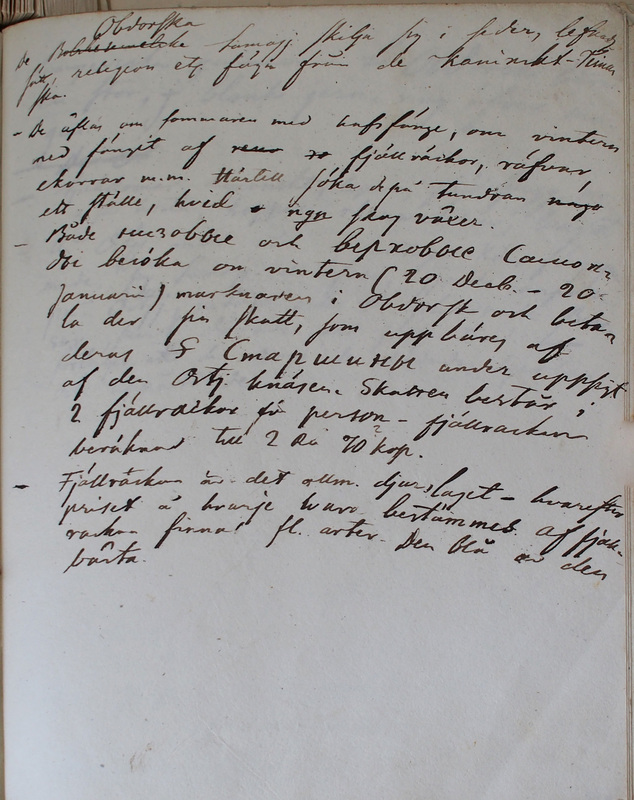Ethnographiska, historiska och statistiska anmärkningar. 260
Title
Ethnographiska, historiska och statistiska anmärkningar. 260
Description
[Pages 247–261 were filled in upside down. The page order has been reversed and page 261 has been reordered between 256 and 255, where it reads better.]
| De Bolshsemelska
Obdorska Samojj.[Samojerna]
skilja sig i seder, lefnads-The following pages concentrate on the so-called Obdorsk Samoyeds. This is a territorial and administrative category referring to the Nenets living near Obdorsk in an administrative unit that at Castrén’s time was known as the Berezov uezd. Castrén visited the area during his first Russian expedition from October 1843 to March 1844. Large-scale pastoralist reindeer herding was well-developed among the Nenets at the time, which is why Castrén’s description of the livelihood is only partial. For the history of the region, see Poberežnikov et al. 2010.
sätt, religion etc. från från de Kaninskt-Timan- ska |
The Obdorsk Samoyeds are different from the Kanin and Timan ones when it comes to customs, ways of living, religion, etc. |
| De äflas om sommaren med hafsfånge, om vintern med fänget af renar fjällräckor, räfvar, ekorrar m.m. Härtill söka de på tundran ett ställe, hvid ngn skog växer. |
They practise sea hunting in the summer; in the winter they hunt Arctic foxes, foxes, squirrels, etc. In order to hunt, they seek a place with some forest in the tundra. |
|
Både
низовые
The Russian designation lower (nizovye) refers to the Nenets living on the lowlands of the rivers Nadym, Taz, and Pur and the shores of the Taz Gulf up to the River Yenisei, whereas upper (verchovye) or stony (kamennye) refers to those Nenets moving on the slopes of the Urals and the Yamal Peninsula. (Alekseev (ed.) 2010: 242, 311). See [paenjaangi]; [Jiesangi].
och верховые Самое-
ды besöka om vintern (20 Dec[ember].-20 Januari) marknaden i Obdorsk i beta la der sin skatt,
som uppbäres afSee [yasak].
deras S Старшины
under uppsigtNenets community leaders, who were obliged to gather yasak and take care of minor disputes, were called leaders in contrast to princes, who had a higher position in the Russian imperial regime. As is known, some Nenets leaders were also called princes and there were constant negotiations about their position in relation to Prince Tajšin. (Perevalova 2019: 47, 74–75, 106–110; Lëzova 2000)
af den Ostj[ak-]. knäsen.
Skatten består iThe princely Tajšin family had led the princedom of Obdorsk since the beginning of the 17th century. The Obdorsk princedom acted wisely between Russian colonial power and indigenous peoples, both Khanty and Nenets, in order to maintain their right to collect taxes and wield power in the court system. Bachrušin mentions the Obdorsk princedom as one of the most significant among the Khanty and Mansi. Although they were obliged to offer some services to the Russian administrators, the princedom enjoyed considerable independence. (Bachrušin 1935: 62–67; Perevalova 2019: 71–77)
2 fjällräckor på person - fjällrackan beräknas till 2 R[ubel]. 70 ? kop[eek]. |
Both the lower and upper Samoyeds visit the Obdorsk market in the winter (20th December–20th January) and there pay their tax, which is collected by their leaders under the supervision of the Ostyak Prince. The tax consists of two Arctic fox [furs] per person – an Arctic fox is evaluated as having a value of 2 roubles 70 kopecks. |
| Fjällräckan är det allm[änsta]. djurslaget - hvarefter priset å hvarje hvaro bestämmes af fjäll- rackan finnas fl[ere]. arter. Den blå äro den bästa. |
The Arctic fox is the most common animal species – and this is why the price of each item is determined by the different types of Arctic foxes. The blue one is the best. |

